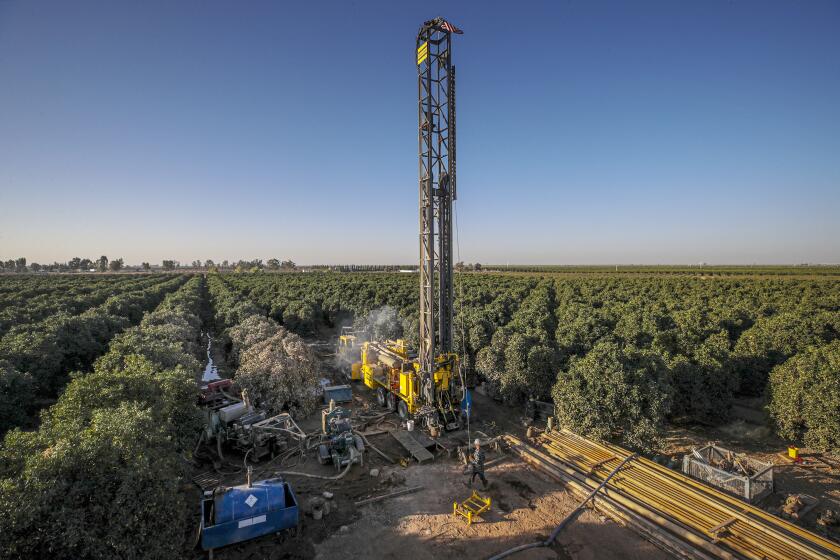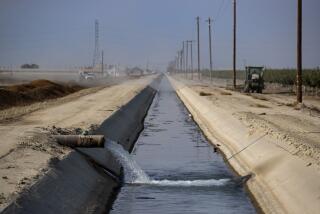‘Full-on crisis’: Groundwater in California’s Central Valley disappearing at alarming rate

- Share via
Scientists have discovered that the pace of groundwater depletion in California’s Central Valley has accelerated dramatically during the drought as heavy agricultural pumping has drawn down aquifer levels to new lows and now threatens to devastate the underground water reserves.
The research shows that chronic declines in groundwater levels, which have plagued the Central Valley for decades, have worsened significantly in recent years, with particularly rapid declines occurring since 2019.
“We have a full-on crisis,” said Jay Famiglietti, a hydrology professor and executive director of the University of Saskatchewan’s Global Institute for Water Security. “California’s groundwater, and groundwater across the southwestern U.S., is disappearing much faster than most people realize.”
Famiglietti and other scientists found in their study, which was published this month in the journal Nature Communications, that since 2019, the rate of groundwater depletion has been 31% greater than during the last two droughts.
They also found that groundwater losses in the Central Valley since 2003 have totaled about 36 million acre-feet, or about 1.3 times the full water-storing capacity of Lake Mead near Las Vegas, the country’s largest reservoir.
California passed its landmark groundwater law in 2014. The goals of sustainable management remain a long way off.
“The trajectory we’re on right now is one for 100% disappearance,” Famiglietti said. “This is the water for the future generations. And it’s disappearing.”
California’s historic Sustainable Groundwater Management Act was passed in 2014 with the intent of curbing overpumping and stabilizing aquifer levels. But the law, known as SGMA, gives many local agencies until 2040 to achieve sustainability goals.
Famiglietti said the findings indicate that timeline may be far too long, pointing to a need to speed up implementation of regulation under the law. The current pace of groundwater losses is now nearly five times faster than the long-term average since the 1960s.
“We are seeing what appears to be a rush to pump as much groundwater as possible before new restrictions take hold,” Famiglietti said. “My fear is that by the time SGMA is fully implemented, it will be too late. There will be nothing left to manage.”
The rush on groundwater comes amid the driest three-year period ever recorded in California, as well as a larger megadrought worsened by global warming that has blanketed the American Southwest for 23 years.
During drought, when less water is available from rivers and canals, agriculture in the Central Valley typically depends on groundwater for two-thirds or more of its water supplies.
The research included analyzing nearly two decades of data from two NASA satellite missions, the latest of which is called GRACE Follow-On. The pair of satellites, which launched into orbit in 2018, track changes in Earth’s gravity field to measure shifts in the total amounts of water, above and below ground.
The scientists examined other data on soil moisture, surface water and snowpack to estimate groundwater losses, and compared their findings with estimates from a computer model developed by the U.S. Geological Survey. They compared the current drought, from September 2019 through December 2021, with earlier largely dry periods from 2006-2011 and 2011-2017.
Data for the last two decades reveal successive drops in average water levels in a stairstep-like pattern, with brief wet periods that only temporarily slowed the declines.
“The water stress level in California is getting higher,” said Pang-Wei Liu, a NASA scientist and the study’s lead author. “The groundwater depletion rate is getting faster, especially in these five, 10 years.”
The Central Valley is one of the world’s major farming regions, producing almonds, pistachios, grapes, walnuts, tangerines, rice and other crops, as well as cattle and dairy products.
The quickening pace of groundwater declines has coincided with shifts in crops. The state’s harvested acreage of almond orchards, according to federal data, has grown from 760,000 acres in 2011 to 1.3 million acres in 2021. Farmers have also planted more pistachio orchards.
Famiglietti said he thinks the recent acceleration in water-level declines is probably driven, at least in part, by farmers planting lucrative orchard crops and drilling deeper wells “before the hammer comes down” with restrictions under the groundwater law. Since SGMA was passed, thousands of new agricultural wells have been drilled in the valley.
The push to drill more irrigation wells and rely more heavily on groundwater has caused problems for shallower domestic wells. This year, more than 1,400 dry wells have been reported to the state, the highest number since officials began tracking reports of dry wells in 2013.
The research shows it’s vital that California keep moving forward with implementation of the law, which requires local agencies to develop groundwater plans and make progress toward their goals, said Felicia Marcus, a researcher at Stanford University who previously led the State Water Resources Control Board. She said the study is a “bright reminder of the fact that we need to act, and that we need to have a framework that enables people to act.”
Curbing overuse will be crucial, she said, as climate change brings more frequent and more intense dry spells.
“With SGMA, we have hope of a future in which people’s kids and grandkids can farm and live in the Central Valley,” Marcus said. “The framework and regulation will be essential.”
In the meantime, people in the Central Valley’s rural communities continue to suffer the consequences as more wells sputter and dry up. Many residents who are living with dry taps have been relying on bottled water, household tanks and truck-delivered water while they wait for solutions.
The draining of the aquifer is causing portions of the valley floor to sink. As falling water levels leave underground spaces in layers of gravel, sand and clay, the ground collapses and permanently reduces the aquifer’s water-storing capacity. In parts of the valley, the land has been sinking about 1 foot each year, a problem that has damaged canals and wells.
Stanford researchers examined how land is sinking in the San Joaquin Valley, finding that slowing or halting subsidence requires rising water levels.
The researchers found that the losses of groundwater far exceed reductions in surface water, snow and soil moisture.
“California has been losing water, and groundwater is the reason,” Famiglietti said. “It’s really the tragedy of the commons.”
The scientists analyzed trends in three areas of the Central Valley — the Sacramento, San Joaquin and Tulare basins — and found that the northern Sacramento basin, which has previously fared better than the southern areas, is also undergoing groundwater depletion.
“The vast majority of California’s water is groundwater. The fact that it is disappearing at rates that are nearly five times faster than historical rates is the equivalent of unconstrained withdrawals from a bank account,” Famiglietti said.
That water savings account, he said, is vital for getting through droughts and is a critical resource for California’s future. He said slowing the pace of withdrawals will be essential to sustain groundwater for future generations.
Famiglietti, the lead researcher on the study, was formerly senior water scientist at NASA’s Jet Propulsion Laboratory. In past research, he and other scientists have used NASA satellite measurements to assess how rapidly groundwater is being extracted in California and across the Colorado River Basin. He has studied groundwater depletion in food-growing regions around the world, from South Asia to the Middle East to the Ogallala Aquifer beneath the Great Plains.
In January, he will start a new job as a professor at Arizona State University.
In many parts of the U.S. and other countries, groundwater remains poorly managed or entirely unmanaged. As wells continue to draw down water levels, the declines in water levels remain largely unseen and underappreciated. Using satellite measurements to track groundwater, Famiglietti and other researchers have found widespread and worsening problems of depletion in many of the world’s major food-producing regions.
Famiglietti said a guiding purpose of the research is to “to make the invisible visible.”
The data reveal a dire picture, he said, in California and throughout the Southwest.
“The pace and scale of its disappearance vastly exceed what can be replaced by any management scheme,” Famiglietti said. “If that groundwater disappears, so too does the food production. That means less produce, food shortages, higher food prices.”
He said many more people are also at risk of losing access to drinking water as falling water levels continue to leave more wells dry.
California’s groundwater law promises to eventually impose restrictions on agricultural water use in the Central Valley as local agencies move toward implementing their groundwater sustainability plans. For now, pumping has yet to fall under restrictions in most areas.
Under the law, sustainable groundwater management is defined as managing water supplies in a way that can be maintained without “causing undesirable results,” such as chronic declines in groundwater levels. Researchers have said that addressing the groundwater deficit could require taking large portions of farmland out of production.
Famiglietti said he thinks California has a historic opportunity to begin to manage and preserve groundwater in the Central Valley before it’s gone.
“It’s disappearing quickly,” he said. “This could be our last shot in California to get it right. And so we need to make sure it works.”









